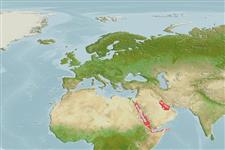Common names from other countries
Environment: milieu / climate zone / depth range / distribution range
Ecologie
marien; brak water rifbewoner; diepte 1 - 30 m (Ref. 89707). Tropical; 31°N - 9°N, 32°E - 55°E (Ref. 5222)
Western Indian Ocean: known only from the Red Sea and Gulf of Aden (Ref. 5222). Reported from Somalia and Socotra (Yemen).
Grootte / Gewicht / Leeftijd
Maturity: Lm ? range ? - ? cm
Max length : 52.0 cm TL mannelijk / geslacht onbekend; (Ref. 9710); common length : 40.0 cm TL mannelijk / geslacht onbekend; (Ref. 5450)
Dorsale stekels (totaal) : 11; Dorsale zachte stralen (totaal) : 14 - 16; Anale stekels: 3; Anale zachte stralen: 8 - 9. Body robust. Serrae at the angle of the preopercle slightly enlarged; the upper edge of the operculum strongly convex. Posterior nostril of adults vertically elongate. Very similar to E. ongus which has longer pectoral fins, and a narrow white margin with broad blackish submarginal band on the median fins, which are absent or poorly developed in E. summana. Generally dark olive-brown to dark brownish gray with large pale blotches (most larger than the eye) and numerous small white spots overlying this pattern. Fins covered with small white spots, except for pectoral fins where the white spots are confined to the base.
Occurs in shallow protected coral reefs and in lagoons or brackish-water environments (Ref. 5222). No published information on the biology of this species has been found (Ref. 5222). Sold fresh in local markets (Ref. 5222).
Levenscyclus en paargedrag
Maturities | Voortplanting | Spawnings | Egg(s) | Fecundities | Larven
Heemstra, P.C. and J.E. Randall, 1993. FAO Species Catalogue. Vol. 16. Groupers of the world (family Serranidae, subfamily Epinephelinae). An annotated and illustrated catalogue of the grouper, rockcod, hind, coral grouper and lyretail species known to date. Rome: FAO. FAO Fish. Synop. 125(16):382 p. (Ref. 5222)
Status op de Rode Lijst van het IUCN (Ref. 130435)
CITES (Ref. 128078)
Not Evaluated
Gevaar voor de mens
Harmless
Gebruik door de mens
Visserij: van minder commercieel belang
Tools
Speciale rapporten
Download XML
Internetbronnen
Estimates based on models
Preferred temperature (Ref.
115969): 25.1 - 29.3, mean 28.6 (based on 150 cells).
Fylogenetische diversiteitsindex (Ref.
82804): PD
50 = 0.5000 [Uniqueness, from 0.5 = low to 2.0 = high].
Bayesian length-weight: a=0.01175 (0.00571 - 0.02419), b=3.04 (2.88 - 3.20), in cm Total Length, based on LWR estimates for this Genus-body shape (Ref.
93245).
Trofisch niveau (Ref.
69278): 3.8 ±0.6 se; based on size and trophs of closest relatives
Weerstandsvermogen (Ref.
120179): Gemiddeld, minimale populatieverdubbelingstijd 1,4-4,4 jaar (Preliminary K or Fecundity.).
Fishing Vulnerability (Ref.
59153): Moderate vulnerability (41 of 100).
Climate Vulnerability (Ref.
125649): Very high vulnerability (83 of 100).
